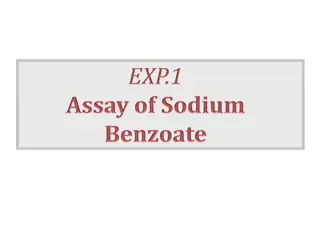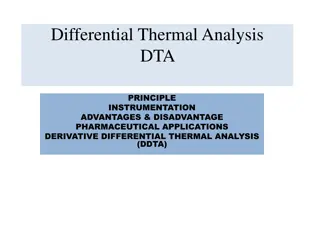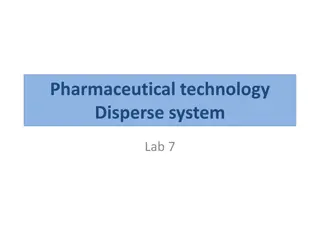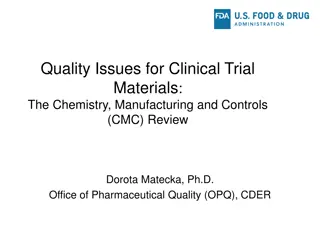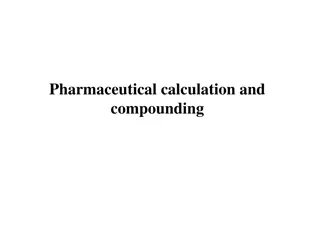Understanding Buffers in Pharmaceutical Formulations
Buffers in pharmacy play a critical role in maintaining constant pH levels essential for drug stability and efficacy. They resist pH changes by neutralizing added acids or bases, ensuring proper drug delivery and patient comfort. Common buffer systems, such as acetic acid/sodium acetate and boric acid/sodium borate, are used for different pharmaceutical formulations and tests. Buffer capacity, defined as the ability to maintain pH despite acid or base additions, is crucial for pharmaceutical dosage forms like injections and ophthalmic solutions. Proper understanding and utilization of buffers are key in pharmaceutical formulation design and quality control processes.
Download Presentation

Please find below an Image/Link to download the presentation.
The content on the website is provided AS IS for your information and personal use only. It may not be sold, licensed, or shared on other websites without obtaining consent from the author. Download presentation by click this link. If you encounter any issues during the download, it is possible that the publisher has removed the file from their server.
E N D
Presentation Transcript
AL-Mustaqbal university college Pharmacy department Pharmaceutical calculation Ghada Ali PhD candidate Dhelal Fouad Mohammed ghada.ali@mustaqbal-college.edu.iq dhilal.foad@mustaqbal-college.edu.iq
Buffers and Buffer solution Lec. 3
Buffers are compounds that resist changes in pH upon the addition of limited amounts of acids or bases. Buffer systems are usually composed of a weak acid or base and its conjugate salt. The components act in such a way that addition of an acid or base results in the formulation of a salt causing only a small change in pH.
Buffer Capacity The ability of a buffer to maintain constant pH is known as its buffer capacity. It is defined as the amount of acid or base that can be added to a given volume of the buffer solution before pH changes to an appreciable degree. A buffer system is most useful at a solution pH at or close to its pKa, because there are adequate concentrations of both the conjugate acid and base forms of the buffer to neutralize added acid or base. Thus, the most effective buffers (with a large buffer capacity) contain the acid and base in large and equal amounts. Pharmaceutical formulations are often buffered to control pH and thus help to minimize drug degradation, improve patient comfort and compliance, or allow delivery of a sufficient drug dose.
In pharmacy, the most common buffer systems are used in (i) the preparation of such dosage forms as injections and ophthalmic solutions, which are placed directly into pH- sensitive body fluids; (ii) the manufacture of formulations in which the pH must be maintained at a relatively constant level to ensure maximum product stability; and (iii) pharmaceutical tests and assays requiring adjustment to or maintenance of a specific pH for analytic purposes.
A buffer solution is usually composed of a weak acid and a salt of the acid, such as acetic acid and sodium acetate, or a weak base and a salt of the base, such as ammonium hydroxide and ammonium chloride. Typical buffer systems that may be used in pharmaceutical formulations include the following pairs: Acetic acid and sodium acetate Boric acid and sodium borate Disodium phosphate and sodium acid phosphate. Formulas for standard buffer solutions for pharmaceutical analysis are given in the United States Pharmacopeia
In the selection of a buffer system, due consideration must be given to the dissociation constant of the weak acid or base to ensure maximum buffer capacity. This dissociation constant, in the case of an acid, is a measure of the strength of the acid; the more readily the acid dissociates, the higher its dissociation constant and the stronger the acid. The dissociation constant, or Ka value, of a weak acid is given by the equation: Because the numeric values of most dissociation constants are small numbers and may vary over many powers of 10, it is more convenient to express them as negative logarithms:
The equation just derived is the Henderson-Hasselbalch equation for weak acids, commonly known as the buffer equation. Similarly, the dissociation constant, or Kb value, of a weak base is given by the equation: and the buffer equation for weak bases, which is derived from this relationship, may be expressed as:
The buffer equation is useful for calculating (1) the pH of a buffer system if its composition is known and (2) the molar ratio of the components of a buffer system required to give a solution of a desired pH . The equation can also be used to calculate the change in pH of a buffered solution with the addition of a given amount of acid or base
pH Review pH = - log [H+] H+ is really a proton Range is from 0 - 14 If [H+] is high, the solution is acidic; pH < 7 If [H+] is low, the solution is basic or alkaline ; pH > 7 10
pH Value of a Salt/Acid Buffer System Calculating the pH value What is the pH of a buffer solution prepared with 0.05 M sodium borate and 0.005 M boric acid? The pKa value of boric acid is 9.24 at 25 . Note that the ratio of the components of the buffer solution is given in molar concentrations. Using the buffer equation for weak acids:
pH Value of a Base/Salt Buffer System Calculating the pH value: What is the pH of a buffer solution prepared with 0.05 M ammonia and 0.05 M ammonium chloride? The Kb value of ammonia is 1.80 105 at 25 . Using the buffer equation for weak bases:
Molar Ratio of Salt/Acid for a Buffer System of Desired pH Calculating the molar ratio of salt/acid required to prepare a buffer system with a desired pH value: What molar ratio of salt/acid is required to prepare a sodium acetate-acetic acid buffer solution with a pH of 5.76? The pKa value of acetic acid is 4.76 at 25 . Using the buffer equation
Quantity of Components in a Buffer Solution to Yield a Specific Volume Calculating the amounts of the components of a buffer solution required to prepare a desired volume, given the molar ratio of the components and the total buffer concentration: The molar ratio of sodium acetate to acetic acid in a buffer solution with a pH of 5.76 is 101. Assuming the total buffer concentration is 2.2 102 mol/L, how many grams of sodium acetate (m.w. 82) and how many grams of acetic acid (m.w. 60) should be used in preparing a liter of the solution? Because the molar ratio of sodium acetate to acetic acid is 10:1,
Change in pH with Addition of an Acid or Base Calculating the change in pH of a buffer solution with the addition of a given amount of acid or base: Calculate the change in pH after adding 0.04 mol of sodium hydroxide to a liter of a buffer solution containing 0.2 M concentrations of sodium acetate and acetic acid. The pKa value of acetic acid is 4.76 at 25 . The pH of the buffer solution is calculated by using the buffer equation as follows
The addition of 0.04 mol of sodium hydroxide converts 0.04 mol of acetic acid to 0.04 mol of sodium acetate. Consequently, the concentration of acetic acid is decreased and the concentration of sodium acetate is increased by equal amounts, according to the following equation Because the pH before the addition of the sodium hydroxide was 4.76, the change in pH 4.94 4.76 0.18 unit, answer.










